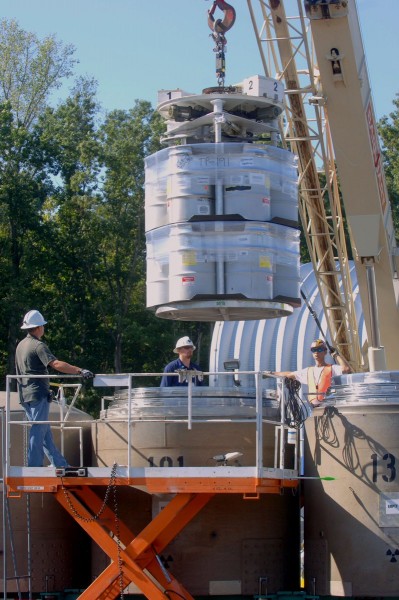
An underground waste facility in southeastern New Mexico that was shut down for about three years after a salt haul truck fire and radiological release will start accepting transuranic waste again in April from places like Oak Ridge. Oak Ridge expects to send 24 shipments of the transuranic, or TRU, waste by January 2018 to the U.S Department of Energy’s Waste Isolation Pilot Plant, or WIPP, near Carlsbad, New Mexico. (Photo by DOE Oak Ridge Office)
An underground waste facility in southeastern New Mexico that was shut down for about three years after a salt haul truck fire and radiological release will start accepting transuranic waste again in April from places like Oak Ridge.
Oak Ridge expects to send 24 shipments of the transuranic, or TRU, waste by January 2018 to the U.S Department of Energy’s Waste Isolation Pilot Plant, or WIPP, near Carlsbad, New Mexico, according to the DOE Oak Ridge Office.
The shipments to be accepted starting in April will be the first received at the facility since the fire and radiological release in February 2014, WIPP said. There was an official re-opening event on Monday, January 9, with remarks by Energy Secretary Ernest Moniz and members of the New Mexico congressional delegation.
Since the closure three years ago, Oak Ridge workers have continued processing waste and developed innovative storage solutions until shipping can resume to WIPP, said Ben Williams, spokesperson for the DOE Oak Ridge Office of Environmental Management.
Oak Ridge Today last reported on TRU waste in December 2015, when North Wind Solutions took over the operation of the Transuranic Waste Processing Center, which is south of Bethel Valley Road on Highway 95 in southwest Oak Ridge.
At that time, North Wind was expected to continue processing and storing transuranic waste until WIPP re-opened in New Mexico. WIPP is the only facility in the U.S. that permanently disposes of transuranic waste, or TRU waste.
In January, Williams said workers at the Transuranic Waste Processing Center, or TWPC, have continued making significant progress, processing a total of 95 percent of Oak Ridge’s inventory of contact-handled waste and 83 percent of its remote-handled waste. Contractors also collaborated to design new protective outer containers to safely store the processed remote-handled waste as it awaits transportation, Williams said.
Also, UCOR, DOE’s cleanup contractor in Oak Ridge, made facilities available to store the inventory of higher radioactive processed waste away from the TWPC, so work can continue there, Williams said.
The Oak Ridge site, which has been open more than a dozen years, treats legacy transuranic waste that has been in storage for many years at Oak Ridge National Laboratory. That includes lab equipment or materials from research and development at ORNL and personal protective equipment. Some of the radioactive materials are handled remotely and others in glove boxes.
Oak Ridge had been sending TRU waste for disposal at WIPP before the two incidents in February 2014. It was sending two types of TRU waste: contact-handled, or CH, and remote-handled, or RH. CH TRU can be manipulated directly with proper personal protection. RH TRU is higher activity material and must be handled mechanically.
Waste is disposed at WIPP in shafts, or drifts, about a half-mile below ground in an ancient salt bed.
Transuranic waste contains manmade elements heavier than uranium, such as plutonium, hence the name “trans†or “beyond†uranium. Transuranic waste material is generally associated with the human manipulation of fissionable material dating back to the Manhattan Project through today, and it primarily consists of clothing, tools, rags, residues, soil, and debris. The Manhattan Project was a top-secret federal program to build the world’s first atomic weapons during World War II.
This year, WIPP said it has safely transported more than 11,800 shipments to its facility, totaling more than 14 million miles.
See previous stories on transuranic waste here.
See the U.S. Department of Energy Operational Readiness Review for the Waste Isolation Pilot Plant from December 2016 here.
See a March 2015 report on the February 2014 accidents at WIPP here. You can also see a DOE explanation here.
More information will be added as it becomes available.

A worker manipulates RH waste at the TRU Waste Processing Center in west Oak Ridge. (File photo courtesy Oak Ridge Site Specific Advisory Board)

The Transuranic Waste Processing Center in west Oak Ridge, south of Bethel Valley Road on Highway 95, is pictured above. (File photo courtesy of U.S. Department of Energy/Oak Ridge Office)
Do you appreciate this story or our work in general? If so, please consider a monthly subscription to Oak Ridge Today. See our Subscribe page here. Thank you for reading Oak Ridge Today.
Copyright 2016 Oak Ridge Today. All rights reserved. This material may not be published, broadcast, rewritten, or redistributed.





Leave a Reply